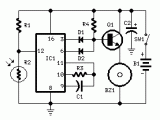FREE
circuits!
Temperature sensor circuit diagrams
December 27, 2010
The heater element (not shown) is connected in series with two back to back 16 amp SCRs (not shown) which are controlled with a small pulse transformer. The pulse transformer has 3 identical windings, two... [more]
December 12, 2010
A simple device to indicate various levels of hot water in a tank. [more]
December 9, 2010
This circuit controls a load (in this case a dc brushless fan) based on a temperature compared with a setpoint. THe transduced is a diode in the forward polarization regime. In fact when forward biased,... [more]
October 25, 2010
This circuit adopt a rather old design technique as its purpose is to vary the speed of a fan related to temperature with a minimum parts counting and avoiding the use of special-purpose ICs, often... [more]
October 23, 2010
The thermistor used has a resistance of 15k at 25 degrees and 45k at 0 degrees celsius. [more]
October 23, 2010
This circuit, enclosed in a small box, is placed in the fridge near the lamp (if any) or the opening. [more]
October 23, 2010
This circuit is intended to control a heating system or central heating plan, keeping constant indoor temperature in spite of wide range changes in the outdoor one. [more]
October 12, 2010
Using a thermistor in the position shown makes a heat activated sensor. A change in temperature will alter the output of the opamp and energize the relay and light the LED. Swapping the position of... [more]
October 4, 2010
Here is a simple thermostat circuit that can be used to control a relay and supply power to a small space heater through the relay contacts. The relay contacts should be rated above the current... [more]
October 4, 2010
In this fire alarm circuit, a Thermistor works as the heat sensor. When temperature increases, its resistance decreases, and vice versa. At normal temperature, the resistance of the Thermistor (TH1) is approximately 10 kilo-ohms, which... [more]
circuit from:http://www.extremecircuits.net/2009/07/fire-alarm-using-thermistor.html










 This category
This category